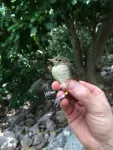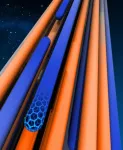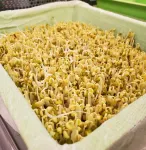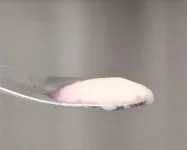With a little help from their friends, older birds breed successfully
2021-01-19
(Press-News.org) The offspring of older animals often have a lower chance of survival because the parents are unable to take care of their young as well as they should. The Seychelles warbler is a cooperatively breeding bird species, meaning that parents often receive help from other birds when raising their offspring. A study led by biologists from the University of Groningen shows that the offspring of older females have better prospects when they are surrounded by helpers. This impact of social behaviour on reproductive success is described in a paper that was published on 19 January in the journal Evolution Letters.
The Seychelles warbler lives on a tiny island called Cousin Island, which is part of the Republic of Seychelles, an island country in the Indian Ocean. On Cousin Island, there are just over 300 birds, nearly all of them ringed with colour rings so that each individual bird can be recognized. The population has been studied for several decades. Martijn Hammers, a biologist at the University of Groningen, has frequently visited the island and is studying the interaction between social behaviour and ageing among these birds.
Natural laboratory
Cousin Island resembles a natural laboratory, Hammers explains. 'It is isolated, so there is no influx of new birds and birds rarely migrate to other islands. Furthermore, from 1985 onwards, we have ringed almost all warblers on the island, which allows us to observe their behaviour, reproduction and survival.' The Seychelles warbler is a cooperative breeder: each territory is held by a dominant couple and they sometimes allow helpers to stay there. 'These helpers are usually their own young from earlier breeding attempts and they can assist in breeding and in feeding the chicks. In return, these helpers can use the resources that are available in the territory and female helpers are occasionally allowed to lay an egg in the dominant birds' nest.'
As the parent birds age, their ability to feed their young diminishes. In this new study, Hammers and his colleagues from the University of Groningen (The Netherlands) and the University of East Anglia (UK) wanted to find out whether social behaviour, in particular the care for offspring provided by helpers, affects the breeding success of older birds. To this end, Hammers analysed over 20 years of data on these birds. He specifically looked at the frequency of chick feeding and the survival of young birds.
Humans
'Our prediction was that having helpers would be beneficial for the survival of chicks from older birds. And this turned out to be true, but only for older females,' says Hammers. The males of this species contribute less to feeding the chicks than females and their behaviour may therefore be less important for offspring survival than the behaviour of the females. 'That may be because the males are not always sure that they are feeding their own offspring since 40 per cent of the young are not their own,' explains Hammers.
The data show that while helpers compensate for age-related declines in female reproductive performance, individual helpers do not work harder when the dominant female is older. 'It appears to be a more passive process, in that older birds recruit more helpers who collectively help more.' The implications of his findings are that it is beneficial for older female birds to display social behaviour - allowing helpers to live in their territory - since it increases their reproductive success. 'It would be interesting to see if this is a general principle that also applies to other animal species, or even to humans.'
In a previous study, Hammers showed that getting help with the kids also slows down the ageing of the parents. 'This effect was also most pronounced in older females. This new study provides additional evidence for an interplay between age and cooperative breeding.'
INFORMATION:
Reference: Martijn Hammers, Sjouke A. Kingma, Lotte A. van Boheemen, Alexandra M. Sparks, Terry Burke, Hannah L. Dugdale, David S. Richardson and Jan Komdeur: Helpers compensate for age-related declines in parental care and offspring survival in a cooperatively breeding bird. Evolution Letters 19 January 2021
[Attachments] See images for this press release:

ELSE PRESS RELEASES FROM THIS DATE:
2021-01-19
Philadelphia, January 19, 2021 - Aged, wild-caught African green monkeys exposed to the SARS-CoV-2 virus developed acute respiratory distress syndrome (ARDS) with clinical symptoms similar to those observed in the most serious human cases of COVID-19, report researchers in The American Journal of Pathology, published by Elsevier. This is the first study to show that African green monkeys can develop severe clinical disease after SARS-CoV-2 infection, suggesting that they may be useful models for the study of COVID-19 in humans.
"Animal models greatly enhance our understanding of diseases. The lack of an animal model for severe manifestations of COVID-19 has hampered our understanding of this form of the disease," explained lead investigator Robert V. Blair, DVM, PhD, ...
2021-01-19
ATLANTA--Georgia State University biology researchers have found that infecting the nasal passages of mice with the virus that causes COVID-19 led to a rapid, escalating attack on the brain that triggered severe illness, even after the lungs were successfully clearing themselves of the virus.
Assistant professor Mukesh Kumar, the study's lead researcher, said the findings have implications for understanding the wide range in symptoms and severity of illness among humans who are infected by SARS-CoV-2, the virus that causes COVID-19.
"Our thinking that it's more of a respiratory disease is not necessarily ...
2021-01-19
HOUSTON - (Jan. 19, 2021) - Carbon nanotube fibers are not nearly as strong as the nanotubes they contain, but Rice University researchers are working to close the gap.
A computational model by materials theorist Boris Yakobson and his team at Rice's Brown School of Engineering establishes a universal scaling relationship between nanotube length and friction between them in a bundle, parameters that can be used to fine-tune fiber properties for strength.
The model is a tool for scientists and engineers who develop conductive fibers for aerospace, automotive, medical and textile applications like smart clothing. Carbon nanotube fibers have been considered as a possible basis for a space elevator, a project Yakobson has studied.
The research ...
2021-01-19
Scleroderma, a chronic and currently incurable orphan disease where tissue injury causes potentially lethal skin and lung scarring, remains poorly understood.
However, the defining characteristic of systemic sclerosis, the most serious form of scleroderma, is irreversible and progressive scarring that affects the skin and internal organs.
Published in iScience, Michigan Medicine's Scleroderma Program and the rheumatology and dermatology departments partnered with the Northwestern Scleroderma Program in Chicago and Mayo Clinic to investigate the causes of ...
2021-01-19
Researchers have revealed the first atomic structures of the respiratory apparatus that plants use to generate energy, according to a study published today in eLife.
The 3D structures of these large protein assemblies - the first described for any plant species - are a step towards being able to develop improved herbicides that target plant respiration. They could also aid the development of more effective pesticides, which target the pest's metabolism while avoiding harm to crops.
Most organisms use respiration to harvest energy from food. Plants use photosynthesis to convert sunlight into sugars, and then respiration to break down the sugars into energy. This involves tiny cell components called mitochondria and a set of five protein assemblies ...
2021-01-19
Provincial and territorial governments should set clear rules for vaccinating health care workers against SARS-CoV-2, the virus that causes COVID-19, in public and private settings, and should not leave this task to employers, according to an analysis in CMAJ (Canadian Medical Association Journal).
"An effective vaccine provided to health care workers will protect both the health workforce and patients, reducing the overall burden of COVID-19 on services and ensuring adequate personnel to administer to people's health needs through the pandemic," writes Dr. Colleen M. Flood, University of Ottawa Research Chair in Health Law & Policy and a ...
2021-01-19
HAMILTON, ON, Jan. 19, 2021 -- McMaster researchers have developed a new form of cultivated meat using a method that promises more natural flavour and texture than other alternatives to traditional meat from animals.
Researchers Ravi Selvaganapathy and Alireza Shahin-Shamsabadi, both of the university's School of Biomedical Engineering, have devised a way to make meat by stacking thin sheets of cultivated muscle and fat cells grown together in a lab setting. The technique is adapted from a method used to grow tissue for human transplants.
The sheets of living cells, each about the thickness of a sheet of printer paper, are first grown in culture and then concentrated on growth plates before being peeled ...
2021-01-19
NANOTECHNOLOGY PREVENTS PREMATURE BIRTH IN MOUSE STUDIES
Media Contact: Rachel Butch, rbutch1@jhmi.edu
In a study in mice and human cells, Johns Hopkins Medicine researchers say that they have developed a tiny, yet effective method for preventing premature birth. The vaginally delivered treatment contains nanosized (billionth of a meter) particles of drugs that easily penetrate the vaginal wall to reach the uterine muscles and prevent them from contracting. If proven effective in humans, the treatment could be one of the only clinical options available to prevent ...
2021-01-19
From a pair of simple principles of evolution--chance mutation and natural selection--nature has constructed an almost unfathomable richness of life around us. Despite our scientific sophistication, human design and engineering have struggled to emulate nature's techniques and her inexhaustible inventiveness. But that may be changing.
In a new perspective article, Stephanie Forrest and Risto Miikkulainen explore a domain known as evolutionary computation (EC), in which aspects of Darwinian evolution are simulated in computer systems.
The study highlights the progress our machines have made in replicating evolutionary processes and what this could mean for engineering design, software refinement, gaming strategy, robotics and even medicine, while fostering a deeper insight ...
2021-01-19
Using cutting-edge DNA sequencing technologies, a group of laboratories in Konstanz, Würzburg, Hamburg and Vienna, led by evolutionary biologist Professor Axel Meyer from the University of Konstanz, succeeded in fully sequencing the genome of the Australian lungfish. The genome, with a total size of more than 43 billion DNA building blocks, is nearly 14 times larger than that of humans and the largest animal genome sequenced to date. Its analysis provides valuable insights into the genetic and developmental evolutionary innovations that made it possible for fish to colonize land. The findings, published online in the journal Nature, expand our understanding of this major evolutionary ...
LAST 30 PRESS RELEASES:
[Press-News.org] With a little help from their friends, older birds breed successfully






